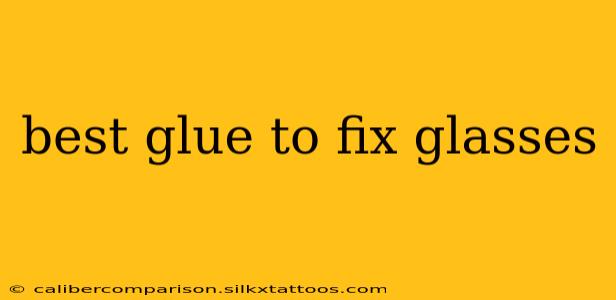Broken glasses? Don't panic! While a trip to the optician is often necessary for significant repairs, many minor fixes can be handled at home with the right adhesive. Choosing the wrong glue can lead to further damage or a poorly repaired frame, so understanding which glue is best for the job is crucial. This guide will help you find the perfect glue to fix your glasses, ensuring a durable and invisible repair.
Understanding Your Glasses Repair Needs
Before diving into glue types, assess the damage. Different glues are suited for different materials and repair types. Consider these factors:
- Material: Are your frames made of plastic, metal, or acetate? Certain glues bond better with specific materials.
- Type of Break: Is it a clean break, a crack, or a loose screw? The repair method will vary depending on the nature of the damage.
- Location of the Break: A break near the hinge requires a different approach than a crack on the temple arm.
The Top Glue Choices for Glasses Repair
Several adhesives are suitable for repairing glasses, each with its strengths and weaknesses. Here’s a breakdown of the best options:
1. Cyanoacrylate (Super Glue)
- Pros: Fast-drying, strong bond, readily available, relatively inexpensive.
- Cons: Can be brittle, may yellow over time, difficult to control application, can potentially damage the frame if applied incorrectly.
- Best for: Small cracks, minor breaks on plastic frames. Use with extreme caution and in tiny amounts.
2. Epoxy Glue
- Pros: Strong, durable bond, suitable for a variety of materials, more forgiving than super glue in terms of application.
- Cons: Longer drying time, requires mixing two components, can be messy.
- Best for: More substantial breaks, repairs on metal or acetate frames. Offers a more robust and long-lasting repair.
3. UV Resin Glue
- Pros: Very strong bond, clear finish, cures quickly with UV light, excellent for precise applications.
- Cons: Requires a UV light source for curing, can be more expensive than other options.
- Best for: Precise repairs, delicate work, invisible repairs on clear frames. Offers a near-invisible and durable bond.
How to Choose the Right Glue for Your Glasses
Here's a simple decision-making process:
- Identify the Material: Plastic frames are generally more forgiving and can tolerate a broader range of glues. Metal and acetate frames require a more robust adhesive like epoxy.
- Assess the Damage: Small cracks or loose parts might respond well to super glue, while larger breaks need epoxy or UV resin.
- Consider Aesthetics: For clear frames, UV resin offers the best invisible repair. For colored frames, epoxy might be a better choice for its durability.
Preparing for the Repair
Regardless of the glue you choose, proper preparation is key to a successful repair:
- Clean the surfaces: Thoroughly clean the broken pieces with a lint-free cloth and isopropyl alcohol. This removes any oils or debris that could prevent proper adhesion.
- Align the pieces: Carefully align the broken pieces before applying the glue. Use clamps or tape to hold them in place while the glue dries.
- Apply sparingly: Too much glue can be detrimental. Use only a tiny amount, just enough to create a bond.
After the Repair
- Drying time: Allow the glue to fully cure according to the manufacturer's instructions.
- Testing the repair: Gently flex the repaired area to test its strength. If it feels weak, it may need additional support or a professional repair.
When to Seek Professional Help
While many minor repairs can be done at home, some damage requires professional attention. If the break is severe, affects the lens alignment, or involves intricate components, it's best to consult an optician or eyeglass repair specialist. They possess the tools and expertise to ensure a proper and long-lasting repair.
This guide provides a comprehensive overview of the best glues for fixing glasses. By carefully considering the type of damage, the material of your frames, and the characteristics of each adhesive, you can make an informed decision and achieve a successful repair. Remember, safety first – always prioritize careful and precise application.

